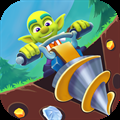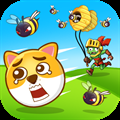
Have you ever looked at a dragon and thought, man, it would be so cool to be like them? In a small way, you can if you pick a dragonborn as the species you play in a Dungeons & Dragons campaign. It may not come with the legendary actions or a sweet lair, but it's a little slice of that power.
RelatedDungeons & Dragons: Elf Species Guide
Graceful and elegant, but deadly, Elves had a beefing up for Dungeons & Dragons' 2024 Player's Handbook.
PostsPlus, you get to look cool, which is just as important. This guide will go over everything that you need to know about dragonborn in the 2024 Player's Handbook, from lore to what exactly has changed for them since the 2014 ruleset.
What Are Dragonborn?
A gathering of dragonborn by David Auden NashSo, yes, dragonborn are descended from the great chromatic and metallicdragons of the multiverse. There are a couple of different theories as to how dragonborn came to be.
The first of which is that Bahamut and Tiamat, who are the dragon gods, wanted to make a species that was in their image. So they blessed eggs, making the creatures who hatched from them bipedal representations of these powerful deities.
The other uh. Well. Some dragons were getting up to some unholy business that was NOT sanctioned by the gods. No names are named, like bards or anything, but regardless, dragonborn were a thing now, whether the gods liked it or not.
While they don't inherit the wings of their dragon ancestors, dragonborn resemble them in every other way, just in a much smaller package. Even the distinct colors of their scales. Which the guide will get into.
Dragonborn Traits
Dragonborn Monk by Joshua RaphaelDragonborn have five different traits, four of which are unique to them. One of them, however, isn't a trait they can use until you've reached level five while playing one.
Trait Names
Descriptions
Draconic Ancestry
You choose which kind of dragon you are descended from.
Breath Weapon
You can use this instead of your traditional attack, unleashing a breath attack similar to dragons.
The damage is based on your Ancestry choice.
Damage Resistance
You gain resistance to the same damage as your Ancestry choice.
Darkvision
You are able to see for 60 feet in dim light and darkness.
Draconic Flight (At Level Five)
You can give yourself spectral wings that last for ten minutes.
This gives you the ability to fly.
Draconic Ancestry has you pick the kind of dragon that you are descended from. Not only do you resemble them in your physical appearance, but it influences both your Breath Weapon and your Damage Resistance feats.
As mentioned before, there are both chromatic and metallic dragons, and those make up the list of your choices.
Chromatic Dragons (Damage Type)
Metallic Dragons (Damage Type)
Black (Acid)
Brass (Fire)
Blue (Lightning)
Bronze (Lightning)
Green (Poison)
Copper (Acid)
Red (Fire)
Gold (Fire)
White (Cold)
Silver (Cold)
For your Breath Weapon, it's not only about what you pick. When you decide to use this as your attack, you get to choose between either a 15-foot cone or a 30-foot long line that is also five feet wide.
Any creature, allies too, who are caught in this must make a Dexterity saving throw.
You can choose the shape of the attack every time you use it, not just when you pick your Ancestry.
They are trying to beat whatever the number is when you add your Consitution modifier and your proficiency bonus plus eight. To simplify, it looks like this: (8 + Con modifier + Proficiency Bonus).
If they fail, they'll take 1d10 damage. The damage typing is determined by the type of dragonborn you are (shown in table above). If they do succeed on their saving throw, then they take half as much damage. But, when you hit certain levels, that damage increases by 1d10. Those levels are five, 11, and 17.
You can use your Breath Weapon only a set amount of times between each long rest. That number is equal to your proficiency bonus, which is also based on what level your character is.
Oat of Vengeance dragonborn by Ignatius BudiFor your Damage Resistance, that is entirely about what you pick when it comes to your Draconic Ancestry. That will also match the damage from the table above and your Breath Weapon.
Darkvision is the one trait that you get that is not something exclusive to a dragonborn's arsenal, as a number of the other species get this ability to see in the dark as well.
It is incredibly helpful, though, and it makes it easy to dungeon dive or explore spaces that don't have much light, like the Underdark.
Then, at fifth level, you can summon forth spectral wings that resemble the wings of your dragon ancestor. Doing so is a bonus action. The wings only stay for ten minutes, but they give you a flying speed that matches your walking speed, which is 30 feet.
You can dismiss them early (but who wants to do that). The only other way they leave you before time is up is if you become incapacitated. You then have to wait until you've completed a long rest before you can use them again.
RelatedDungeons & Dragons: Recharge, Explained
Before you burn through a monster's most powerful moves, you might want to familiarize yourself with recharge. This guide will help with that.
PostsWhich Class Should You Consider?
Warlock dragonborn by Ignatius BudiThere are some different schools of thought. You can go down the spellcaster route or take up a class that doesn't naturally have access to spells.
If you're leaning toward spellcaster, it is so helpful to have your Breath Weapon as an extra attack so you aren't burning through all of your spell slots.
If you're deciding between the more martial classes, not only is the Breath Weapon going to provide you a longer distance attack you can use. It also gives you that helpful Resistance, which can bail you out when you are in the middle of a fray.
The spellcasting classes that would get the most use from your natural abilities are the squishiest of the bunch: sorcerers, warlocks, and wizards.
Clerics have access to the best armor and can be up in the middle of the action alongside the fighters and barbarians. Druids can transform into a beast that will keep them safe.
Sorcerers, warlocks, and wizards typically don't have much armor, if any at all. So, if an enemy is bearing down on you, you can hit them with a powerful breath-based attack. And, of course, when you hit level five, you can use your wings to get out of tricky situations.
Dragonborn barbarian by Ignatius BudiFor the physical fighters, there isn't really a wrong choice. With that said, think about being a barbarian. All the martial classes can make use of the Breath Weapon and Damage Resistance. But barbarians will become more fortified in their defense and could really use that ability to fly.
When barbarians use their Rage, they gain resistance to the standard physical damage types of bludgeoning, piercing, and slashing. They will now, as a dragonborn, have a fourth resistance. It's one more option that lets you be a wall for your team.
Then, with the Draconic Flight, if your foes are airborne, you don't have to stare at them with all the rage in your heart without being able to hit them. You can chase them down. No one on land or in the sky is safe from catching your blades with their face.
Differences In The 2024 Player's Handbook
Artwork by Ignatius Budi via Wizards of the CoastThere are two major differences. That is to their Breath Weapon and regarding their Draconic Flight. Other changes are choices made across the board, such as no species gaining additional points to their abilities and learning different languages.
In the 2014 Player's Handbook, when you chose the type of dragonborn from your Breath Weapon, it also determined the shape of the attackand the type of saveneeded to try and avoid the damage.
Not only did your choice influence the type of damage. Even your alignment was meant to side with either Bahamut or Tiamat, making you good or evil.
You didn't have to stay true to that description, but it was suggested that your dragonborn would follow that when choosing your alignment.
As an example, black dragonborn had a 30-foot line, and the creatures caught in it needed to make a Dexterity saving throw. But green dragonborn had a 15-foot cone, and creatures had to roll a Constitution saving throw.
While it made each dragonborn more individualistic, you were locked into the shape and couldn't adjust to the current combat situation. Plus, for Dungeons Masters (DMs), having every Breath Weapon have the same saving throw makes it all less confusing.
For Draconic Flight, dragonborn didn't have it, or the ability to fly. This makes dragonborn stronger all around as this replaces the trait about which languages they would learn. If you had to pick between learning a language and flying, which would you choose? There is a right answer.
NextDungeons & Dragons: Aasimar Species Guide
Want to know everything about aasimar in the Player's Handbook 2024? Then click the guide link my child and be enlightened.
Posts












